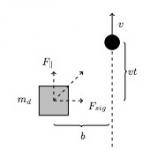Paper of the month: Probing the Microscopic Gravitational Interactions of Dark Matter

March 15, 2019 by Bruno Martin
The current evidence for the existence of dark matter comes exclusively from astrophysical and cosmological indirect observations of dark matter’s gravitational interactions. These are observations which cumulatively average the gravitational forces exerted by dark matter on macroscopic astrophysical bodies (e.g. stars, galaxies, galaxy clusters), and so inherently these observations cannot distinguish any of the microscopic properties of dark matter.
Despite enormous efforts to detect dark matter directly in a lab, so far no new evidence has been found to reveal the particle nature of dark matter. All of these efforts have assumed dark matter interacts with Standard Model particles either directly or mediated by some new force of the hidden dark sector.
Given what is known about dark matter to date, one might wonder whether it is possible to construct a tabletop experiment capable of directly measuring gravitational interactions of the particles themselves, rather than the cumulative effect of the dark matter phase space averaged over astrophysical scales (as is done e.g. with measurements of rotation curves and stellar kinematics); such an experiment may allow physicists to directly infer the mass of particle dark matter. This is exactly the idea behind a recent proposal by [1], where it was argued that existing technology could be used to construct centimeter scale detectors that can identify the correlated gravitational pull that would be exerted gravitationally as dark matter passes through Earth.
The proposal of [1] would pave a new path in the realm of direct dark matter detection which is not subject to model-specific properties, and would narrow the search for dark matter by looking for the one known interaction. This experiment relies on the technological developments in atomic, molecular, and optical physics, and in particular on the developments of the largely successful gravitational wave observatories such as LIGO [2]. In recent years these fields have pushed mechanical systems to the quantum limit in the hope of performing ultra-high precision measurements. While gravitionational interferometers have focused on measuring continuous deviations from an approximately sinusoidal waveform, this experiment would instead attempt to measure a temporary impulse arising from a transient dark matter particle.
As shown in Figure 1, an individual detector will experience a small time-dependent gravitational pull as the particle passes through the detector; by configuring a collection of such detectors in the form of a lattice (see Figure 2), it may be possible to use correlated detector responses to identify the trajectory and velocity of the passing particle. The mass of the transient dark matter particle can then be inferred from the overall interaction strength. As the mass of the particle decreases, the signal weakens, and noise due to the thermal motion of the detectors begins to dominate. On the hand, for larger dark matter masses the local number density of dark matter is reduced, an observation is less likely. Consequently, the proposed experimental design is only sensitive to dark matter with a mass near the Planck scale; thus, while this experiment will not be sensitive to many of the favored dark matter candidates (namely any candidate which is non-composite), it represents a new model-independent approach to the identification of the fundamental properties of dark matter.
We emphasize that while this proposal represents a novel and intriguing step for the direct detection of dark matter, it is at the moment merely a conceptual design. The authors present an honest assessment of some of the major experimental challenges that will inevitably need to be confronted, however like all experiments, new problems and systematics always arise in its realization. A fundamental proof of principle will need to be demonstrated before the technology can be considered feasible. While detecting a new particle gravitationally is an ambitious goal, if dark matter only interacts with the visible world through gravity then it may be our best hope for discovering the fundamental constituents of dark matter.

Figure 1: A dark matter particle gravitationally interacts with the detector mass.

Figure 2: An illustration of an array of detectors
----------------------------------------------------------------------------------------------------------------
[1] D. Carney, S. Ghosh, G. Krnjaic and J. M. Taylor, arXiv:1903.00492 [hep-ph]
[2] J. Aasi et al. [LIGO Scientific Collaboration], Class. Quant. Grav. 32 (2015) 074001 doi:10.1088/0264-9381/32/7/074001 [arXiv:1411.4547 [gr-qc]]


